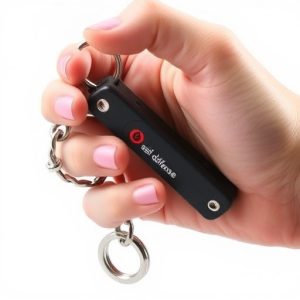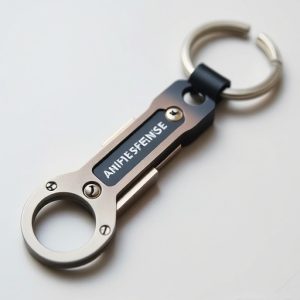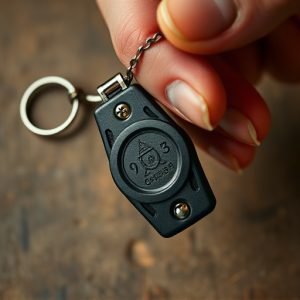Mastering Metal Keychain Design: Grip, Comfort, and Durability
The Proper Keychain Striking Form Technique is vital for creating durable, ergonomic, and aesthetica…….
The Proper Keychain Striking Form Technique is vital for creating durable, ergonomic, and aesthetically pleasing metal keychains. By focusing on factors like thickness, corner radii, and geometry, designers can enhance both functionality and visual appeal. This technique ensures even weight distribution, perfect palm alignment, and longevity, addressing weaknesses caused by improper forming. Key components include selecting high-quality metal alloys, prioritizing smooth surfaces for user comfort and grip security, and maintaining consistent thickness to prevent warping. Mastering this technique results in a tactical keychain offering reliable control and comfort during critical moments, appealing to self-defense enthusiasts.
In the realm of metal defense keychain design, mastering the art of striking form is key to crafting durable, comfortable, and aesthetically pleasing tools. Understanding the importance of proper keychain striking form technique empowers users with a secure grip, enhancing their control during critical moments. This article delves into essential components for achieving solid consistency, techniques for user comfort, and tips for creating metal keychains that blend functionality with beauty.
- Understanding the Importance of Striking Form in Metal Keychain Design
- Key Components for Achieving a Solid and Consistent Grip
- Techniques to Enhance User Comfort and Control
- Tips for Crafting a Durable and Esthetically Pleasing Keychain
Understanding the Importance of Striking Form in Metal Keychain Design
In metal keychain design, understanding the importance of striking form is paramount to creating functional and aesthetically pleasing products. The proper keychain striking form technique refers to the method used to shape and mold metal into a compact, durable, and ergonomic keychain. It involves careful consideration of factors such as thickness, corner radii, and overall geometry to ensure both strength and comfort in hand. A well-executed striking form not only enhances the keychain’s durability but also contributes significantly to its visual appeal.
Adhering to the proper keychain striking form technique allows designers to mitigate weaknesses that can arise from improper metal forming. For instance, sharp corners or uneven thicknesses can lead to stress concentrations, making the keychain more prone to breakage. By optimizing these aspects, manufacturers can produce keychains that withstand everyday use, ensuring they remain in top condition over time. This attention to detail not only satisfies users’ functional needs but also elevates the overall user experience.
Key Components for Achieving a Solid and Consistent Grip
To craft a metal defense keychain with an exceptional grip, attention must be given to key components that contribute to its solidity and consistency. The design should prioritize a proper keychain striking form technique, ensuring the weight is evenly distributed and the strike surface aligns perfectly with the user’s palm. This involves creating a balanced geometry where the keychain’s weight doesn’t shift abruptly during use.
The materials play a significant role, too. High-quality metal alloys offer both strength and flexibility, allowing for a comfortable grip without sacrificing durability. Smooth, well-polished surfaces enhance the user experience by preventing discomfort or slippage. Incorporating these elements creates a keychain that not only looks tactical but also functions as intended, providing users with a reliable and consistent grip during critical moments.
Techniques to Enhance User Comfort and Control
When designing a metal defense keychain, focusing on user comfort and control is crucial for ensuring the grip’s effectiveness during stressful situations. One key technique to enhance control is mastering the proper keychain striking form. This involves positioning your hand and wrist correctly while gripping the keychain. The goal is to align your wrist in a neutral position, allowing for quick and precise movements without excess strain. Practicing this form can significantly improve your ability to maintain control during intense moments.
Additionally, incorporating ergonomic designs into the keychain’s structure further enhances user comfort. This includes selecting materials that provide a secure yet comfortable grip. Textured surfaces or rubberized coatings can prevent slipping and reduce fatigue, enabling users to keep a firm hold for extended periods. By combining proper striking form with thoughtful ergonomics, you create a metal defense keychain that offers superior control and comfort, making it an invaluable tool for self-defense enthusiasts.
Tips for Crafting a Durable and Esthetically Pleasing Keychain
Crafting a durable and aesthetically pleasing keychain involves mastering the art of the proper striking form technique. The process begins with envisioning your design, ensuring it translates well into a 3D object. Choose a metal that balances strength and workability, like stainless steel or aluminum. When forming the keychain, maintain a consistent thickness to prevent warping or weak points. This consistency is key in achieving both functionality and visual appeal.
Consider the ergonomics as well—the keychain should fit comfortably in your hand. A well-struck keychain will have smooth curves without sharp edges, enhancing its grippability. The finish plays a vital role too; opt for a matte or satin finish to prevent fingerprints and showcase the metal’s natural beauty. By combining these elements, you’ll create a striking, durable keychain that combines form and function.
When it comes to crafting metal defense keychains, attention to striking form is essential. By combining solid grip components, user-friendly techniques, and durable design principles, you can create a keychain that not only protects your keys but also enhances your daily carry experience. Implement these metal keychain grip design tips to achieve the perfect balance of functionality and aesthetics using the proper striking form technique.


